Effects of Dividends on Share Price: BUSN20019 Project Report Analysis
VerifiedAdded on 2023/04/23
|21
|5967
|280
Project
AI Summary
This project report examines the impact of dividend policies on share prices, with a specific focus on the Australian banking sector. The study investigates the relationship between dividends and share price fluctuations, employing both descriptive and correlation analyses. It explores the effects of dividend payouts on investor behavior and market valuation, referencing the dividend discount model and relevant literature. The research includes a critical literature review, data analysis of four major Australian banks (Commonwealth Bank of Australia, NAB, ANZ, and Westpac), and a discussion of research limitations and future research scope. The project aims to understand the influence of dividend strategies on financial performance, providing valuable insights for investors and financial institutions. The report includes an executive summary, table of contents, introduction, literature review, research methodology, findings, discussion, conclusion, recommendations, and references. The report also includes data from the annual reports of four major banks in Australia for five years, with the aim of assessing the impact of dividends on share prices. The research utilizes secondary data collection methods for a comprehensive financial analysis.
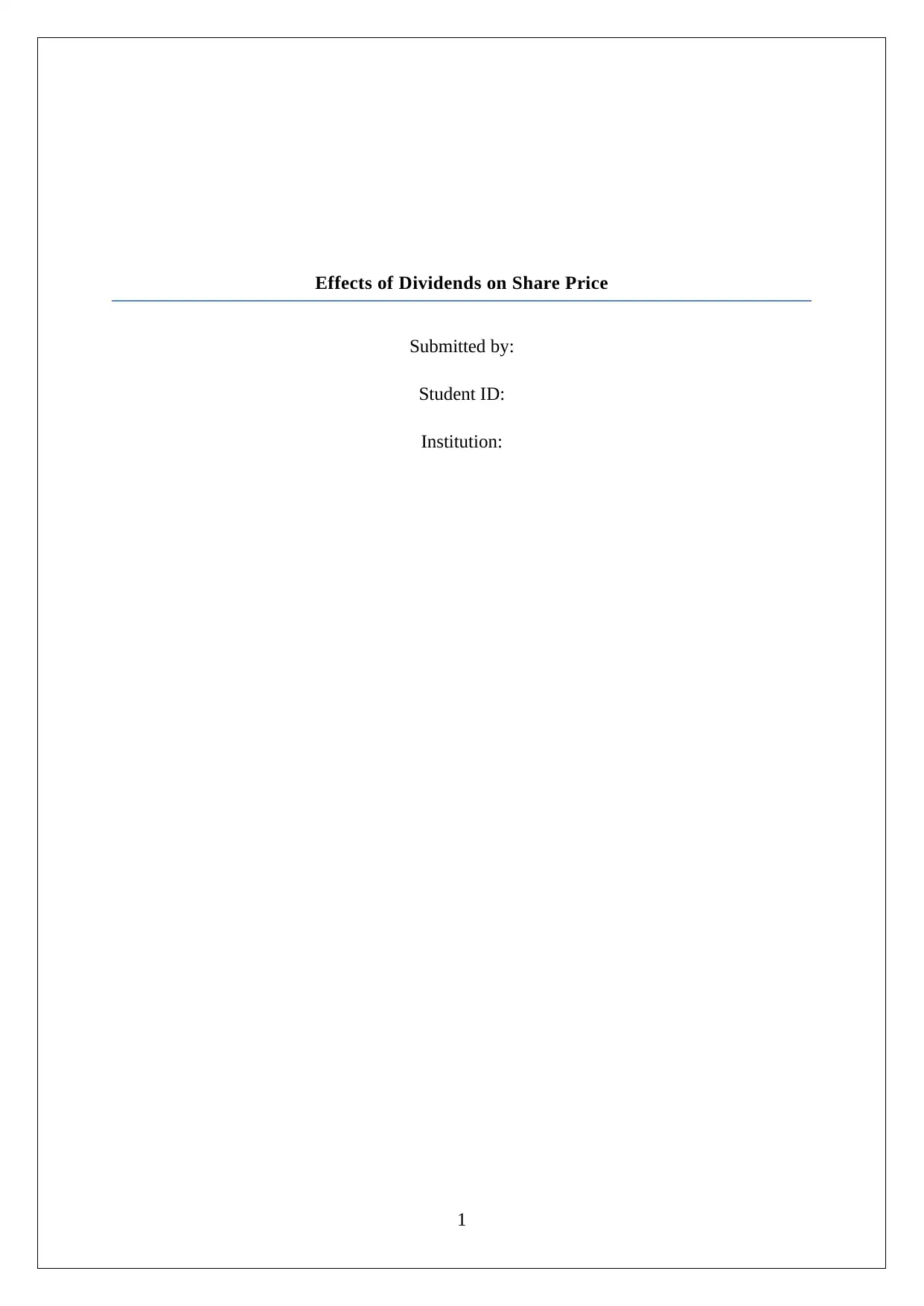
Effects of Dividends on Share Price
Submitted by:
Student ID:
Institution:
1
Submitted by:
Student ID:
Institution:
1
Paraphrase This Document
Need a fresh take? Get an instant paraphrase of this document with our AI Paraphraser
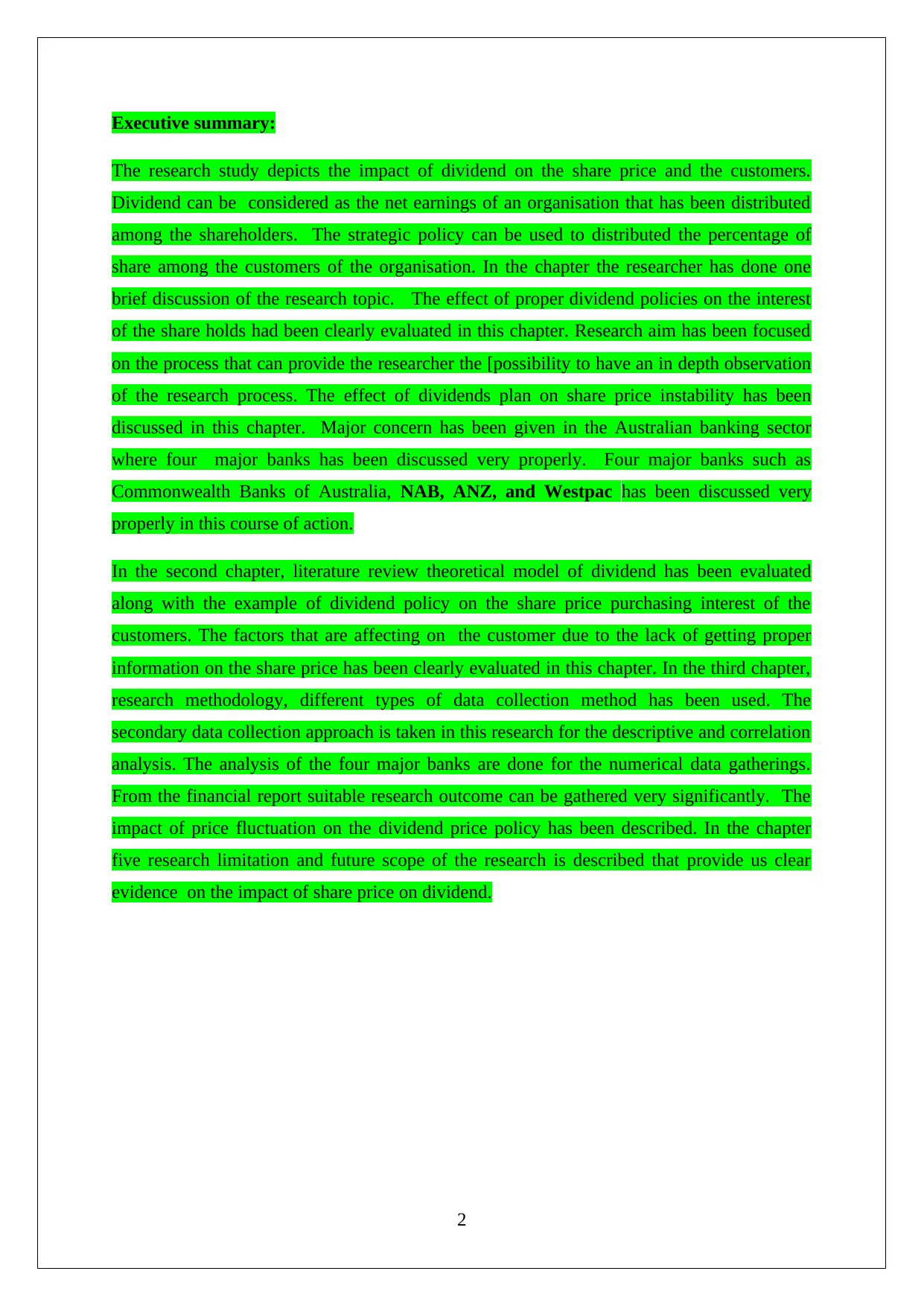
Executive summary:
The research study depicts the impact of dividend on the share price and the customers.
Dividend can be considered as the net earnings of an organisation that has been distributed
among the shareholders. The strategic policy can be used to distributed the percentage of
share among the customers of the organisation. In the chapter the researcher has done one
brief discussion of the research topic. The effect of proper dividend policies on the interest
of the share holds had been clearly evaluated in this chapter. Research aim has been focused
on the process that can provide the researcher the [possibility to have an in depth observation
of the research process. The effect of dividends plan on share price instability has been
discussed in this chapter. Major concern has been given in the Australian banking sector
where four major banks has been discussed very properly. Four major banks such as
Commonwealth Banks of Australia, NAB, ANZ, and Westpac has been discussed very
properly in this course of action.
In the second chapter, literature review theoretical model of dividend has been evaluated
along with the example of dividend policy on the share price purchasing interest of the
customers. The factors that are affecting on the customer due to the lack of getting proper
information on the share price has been clearly evaluated in this chapter. In the third chapter,
research methodology, different types of data collection method has been used. The
secondary data collection approach is taken in this research for the descriptive and correlation
analysis. The analysis of the four major banks are done for the numerical data gatherings.
From the financial report suitable research outcome can be gathered very significantly. The
impact of price fluctuation on the dividend price policy has been described. In the chapter
five research limitation and future scope of the research is described that provide us clear
evidence on the impact of share price on dividend.
2
The research study depicts the impact of dividend on the share price and the customers.
Dividend can be considered as the net earnings of an organisation that has been distributed
among the shareholders. The strategic policy can be used to distributed the percentage of
share among the customers of the organisation. In the chapter the researcher has done one
brief discussion of the research topic. The effect of proper dividend policies on the interest
of the share holds had been clearly evaluated in this chapter. Research aim has been focused
on the process that can provide the researcher the [possibility to have an in depth observation
of the research process. The effect of dividends plan on share price instability has been
discussed in this chapter. Major concern has been given in the Australian banking sector
where four major banks has been discussed very properly. Four major banks such as
Commonwealth Banks of Australia, NAB, ANZ, and Westpac has been discussed very
properly in this course of action.
In the second chapter, literature review theoretical model of dividend has been evaluated
along with the example of dividend policy on the share price purchasing interest of the
customers. The factors that are affecting on the customer due to the lack of getting proper
information on the share price has been clearly evaluated in this chapter. In the third chapter,
research methodology, different types of data collection method has been used. The
secondary data collection approach is taken in this research for the descriptive and correlation
analysis. The analysis of the four major banks are done for the numerical data gatherings.
From the financial report suitable research outcome can be gathered very significantly. The
impact of price fluctuation on the dividend price policy has been described. In the chapter
five research limitation and future scope of the research is described that provide us clear
evidence on the impact of share price on dividend.
2
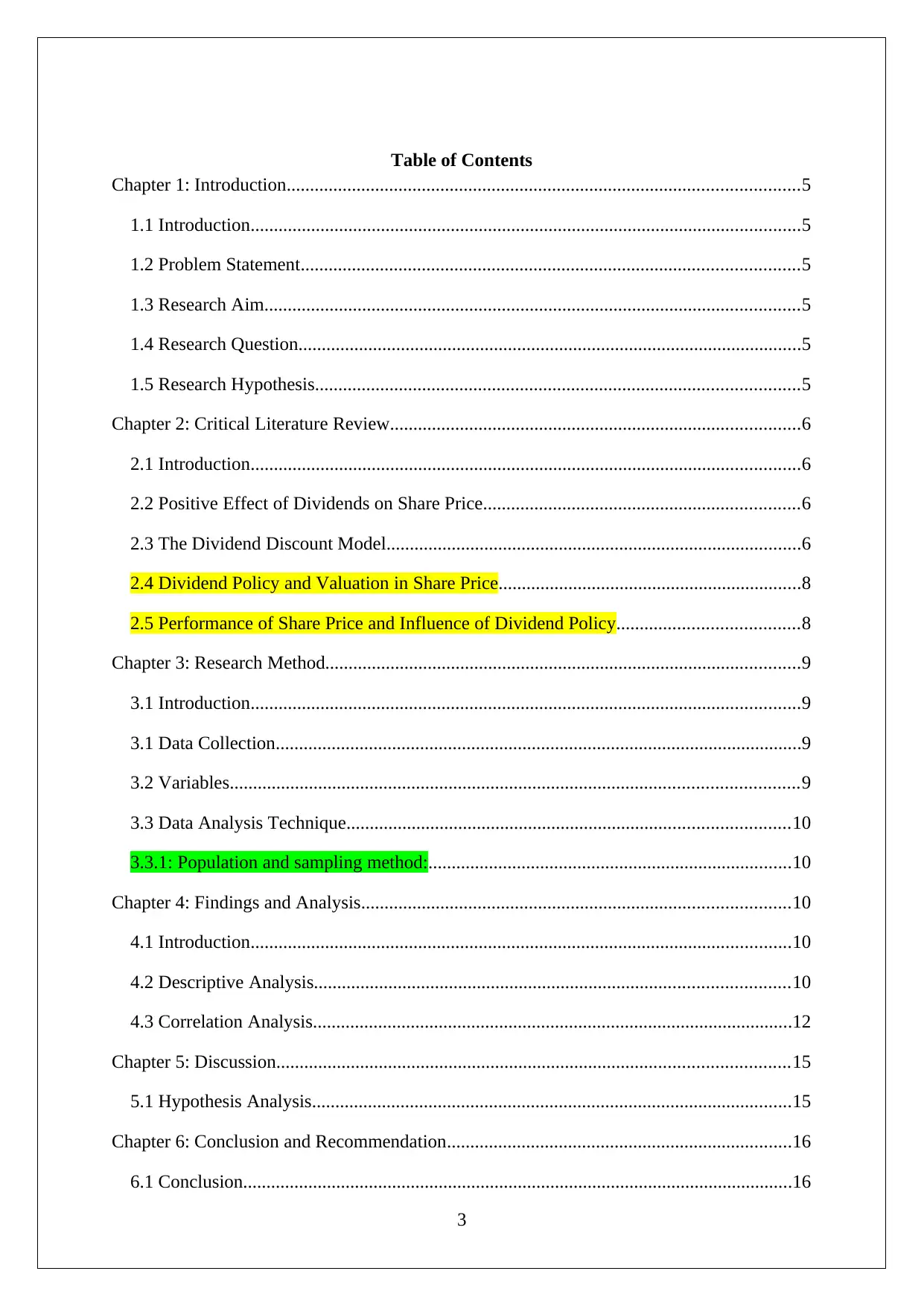
Table of Contents
Chapter 1: Introduction..............................................................................................................5
1.1 Introduction......................................................................................................................5
1.2 Problem Statement...........................................................................................................5
1.3 Research Aim...................................................................................................................5
1.4 Research Question............................................................................................................5
1.5 Research Hypothesis........................................................................................................5
Chapter 2: Critical Literature Review........................................................................................6
2.1 Introduction......................................................................................................................6
2.2 Positive Effect of Dividends on Share Price....................................................................6
2.3 The Dividend Discount Model.........................................................................................6
2.4 Dividend Policy and Valuation in Share Price.................................................................8
2.5 Performance of Share Price and Influence of Dividend Policy.......................................8
Chapter 3: Research Method......................................................................................................9
3.1 Introduction......................................................................................................................9
3.1 Data Collection.................................................................................................................9
3.2 Variables..........................................................................................................................9
3.3 Data Analysis Technique...............................................................................................10
3.3.1: Population and sampling method:..............................................................................10
Chapter 4: Findings and Analysis............................................................................................10
4.1 Introduction....................................................................................................................10
4.2 Descriptive Analysis......................................................................................................10
4.3 Correlation Analysis.......................................................................................................12
Chapter 5: Discussion..............................................................................................................15
5.1 Hypothesis Analysis.......................................................................................................15
Chapter 6: Conclusion and Recommendation..........................................................................16
6.1 Conclusion......................................................................................................................16
3
Chapter 1: Introduction..............................................................................................................5
1.1 Introduction......................................................................................................................5
1.2 Problem Statement...........................................................................................................5
1.3 Research Aim...................................................................................................................5
1.4 Research Question............................................................................................................5
1.5 Research Hypothesis........................................................................................................5
Chapter 2: Critical Literature Review........................................................................................6
2.1 Introduction......................................................................................................................6
2.2 Positive Effect of Dividends on Share Price....................................................................6
2.3 The Dividend Discount Model.........................................................................................6
2.4 Dividend Policy and Valuation in Share Price.................................................................8
2.5 Performance of Share Price and Influence of Dividend Policy.......................................8
Chapter 3: Research Method......................................................................................................9
3.1 Introduction......................................................................................................................9
3.1 Data Collection.................................................................................................................9
3.2 Variables..........................................................................................................................9
3.3 Data Analysis Technique...............................................................................................10
3.3.1: Population and sampling method:..............................................................................10
Chapter 4: Findings and Analysis............................................................................................10
4.1 Introduction....................................................................................................................10
4.2 Descriptive Analysis......................................................................................................10
4.3 Correlation Analysis.......................................................................................................12
Chapter 5: Discussion..............................................................................................................15
5.1 Hypothesis Analysis.......................................................................................................15
Chapter 6: Conclusion and Recommendation..........................................................................16
6.1 Conclusion......................................................................................................................16
3
⊘ This is a preview!⊘
Do you want full access?
Subscribe today to unlock all pages.

Trusted by 1+ million students worldwide
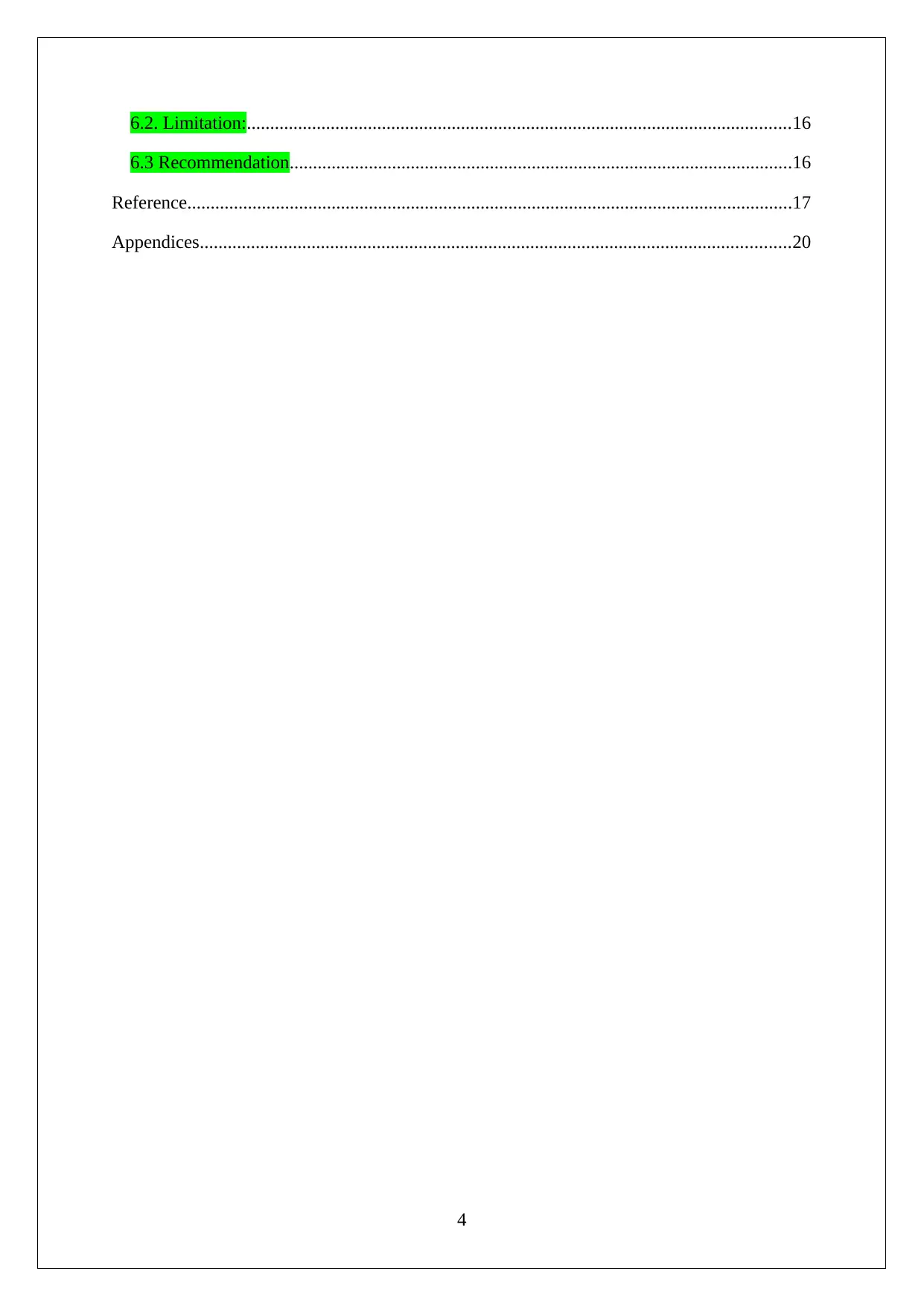
6.2. Limitation:.....................................................................................................................16
6.3 Recommendation............................................................................................................16
Reference..................................................................................................................................17
Appendices...............................................................................................................................20
4
6.3 Recommendation............................................................................................................16
Reference..................................................................................................................................17
Appendices...............................................................................................................................20
4
Paraphrase This Document
Need a fresh take? Get an instant paraphrase of this document with our AI Paraphraser
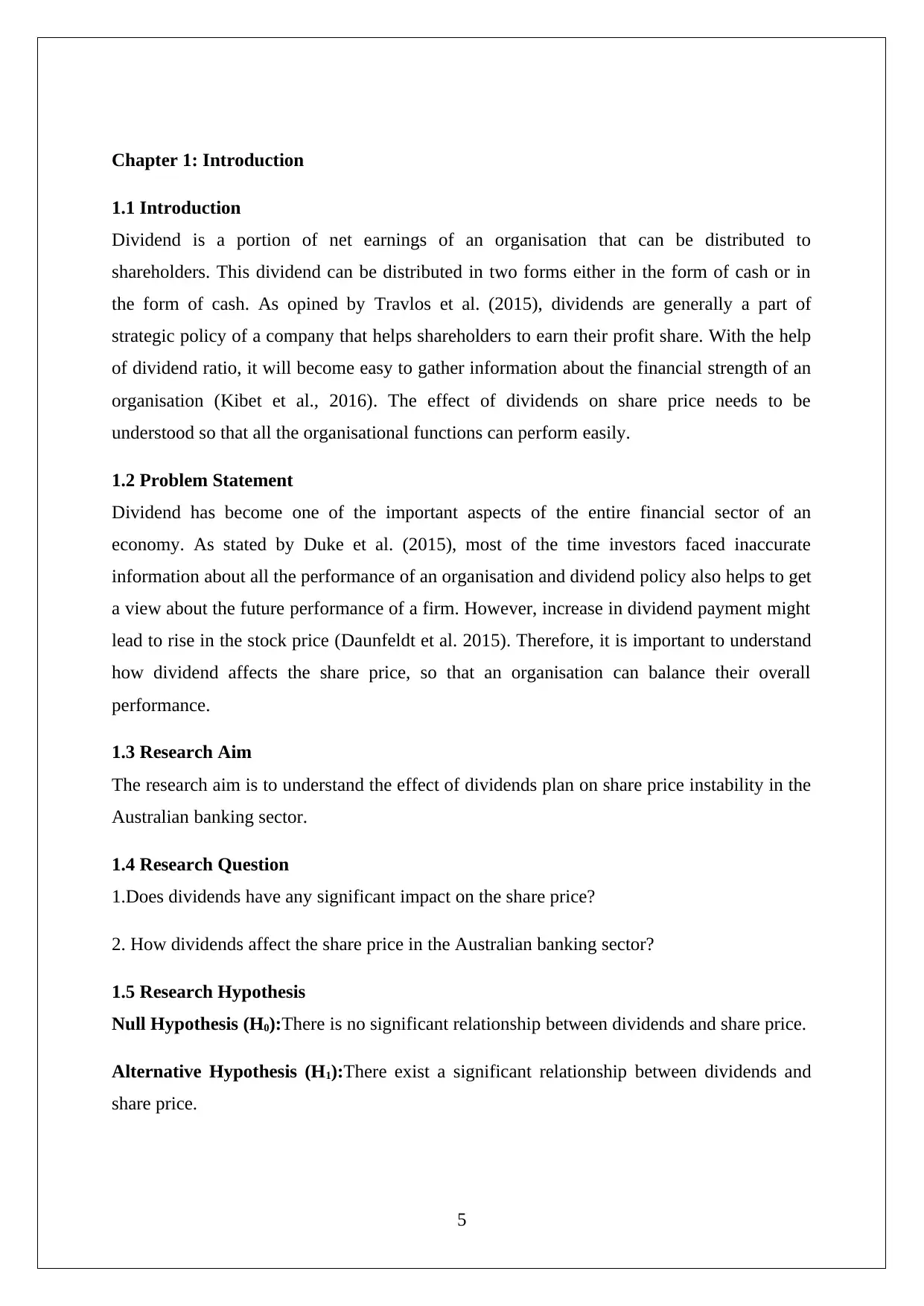
Chapter 1: Introduction
1.1 Introduction
Dividend is a portion of net earnings of an organisation that can be distributed to
shareholders. This dividend can be distributed in two forms either in the form of cash or in
the form of cash. As opined by Travlos et al. (2015), dividends are generally a part of
strategic policy of a company that helps shareholders to earn their profit share. With the help
of dividend ratio, it will become easy to gather information about the financial strength of an
organisation (Kibet et al., 2016). The effect of dividends on share price needs to be
understood so that all the organisational functions can perform easily.
1.2 Problem Statement
Dividend has become one of the important aspects of the entire financial sector of an
economy. As stated by Duke et al. (2015), most of the time investors faced inaccurate
information about all the performance of an organisation and dividend policy also helps to get
a view about the future performance of a firm. However, increase in dividend payment might
lead to rise in the stock price (Daunfeldt et al. 2015). Therefore, it is important to understand
how dividend affects the share price, so that an organisation can balance their overall
performance.
1.3 Research Aim
The research aim is to understand the effect of dividends plan on share price instability in the
Australian banking sector.
1.4 Research Question
1.Does dividends have any significant impact on the share price?
2. How dividends affect the share price in the Australian banking sector?
1.5 Research Hypothesis
Null Hypothesis (H0):There is no significant relationship between dividends and share price.
Alternative Hypothesis (H1):There exist a significant relationship between dividends and
share price.
5
1.1 Introduction
Dividend is a portion of net earnings of an organisation that can be distributed to
shareholders. This dividend can be distributed in two forms either in the form of cash or in
the form of cash. As opined by Travlos et al. (2015), dividends are generally a part of
strategic policy of a company that helps shareholders to earn their profit share. With the help
of dividend ratio, it will become easy to gather information about the financial strength of an
organisation (Kibet et al., 2016). The effect of dividends on share price needs to be
understood so that all the organisational functions can perform easily.
1.2 Problem Statement
Dividend has become one of the important aspects of the entire financial sector of an
economy. As stated by Duke et al. (2015), most of the time investors faced inaccurate
information about all the performance of an organisation and dividend policy also helps to get
a view about the future performance of a firm. However, increase in dividend payment might
lead to rise in the stock price (Daunfeldt et al. 2015). Therefore, it is important to understand
how dividend affects the share price, so that an organisation can balance their overall
performance.
1.3 Research Aim
The research aim is to understand the effect of dividends plan on share price instability in the
Australian banking sector.
1.4 Research Question
1.Does dividends have any significant impact on the share price?
2. How dividends affect the share price in the Australian banking sector?
1.5 Research Hypothesis
Null Hypothesis (H0):There is no significant relationship between dividends and share price.
Alternative Hypothesis (H1):There exist a significant relationship between dividends and
share price.
5
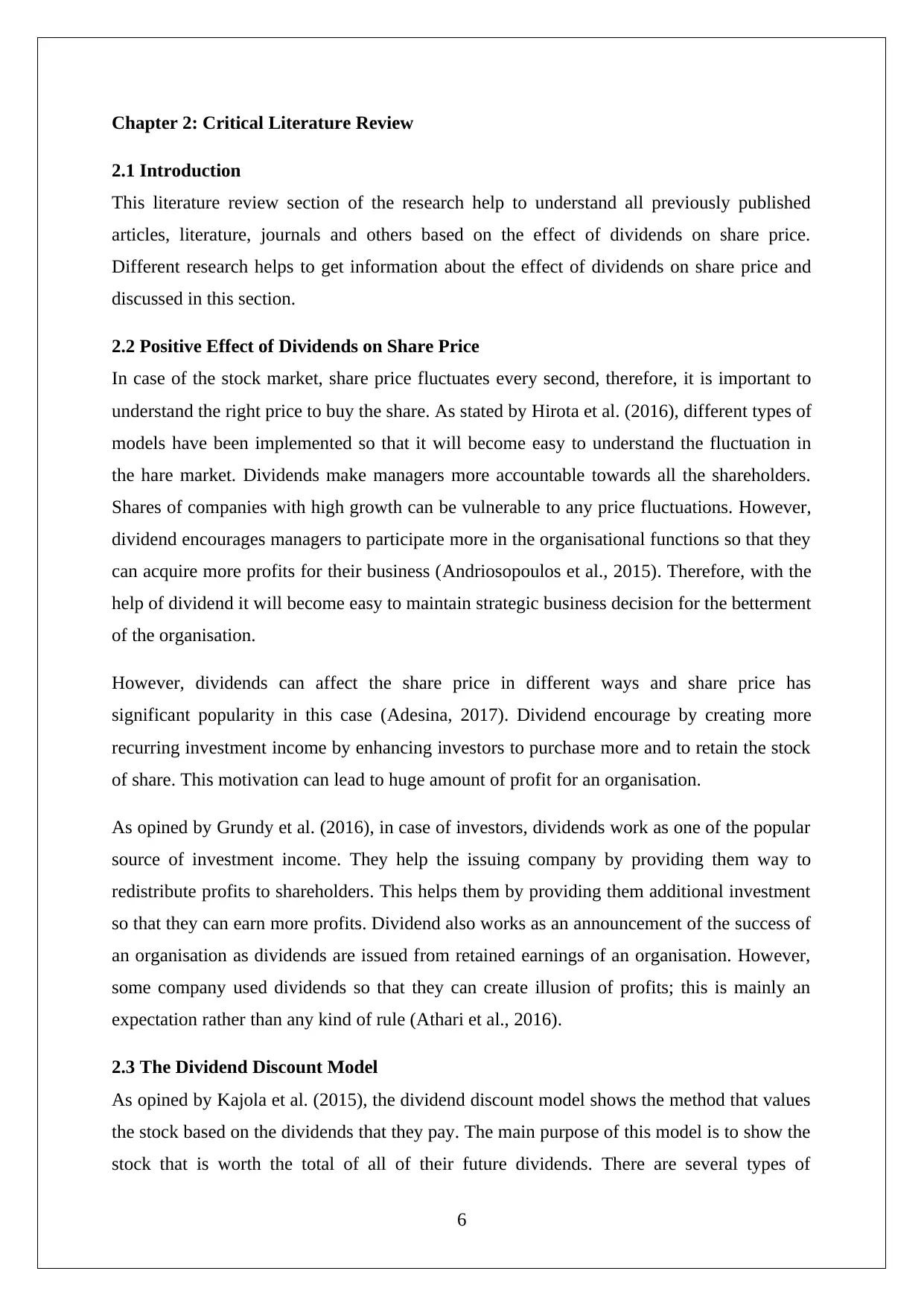
Chapter 2: Critical Literature Review
2.1 Introduction
This literature review section of the research help to understand all previously published
articles, literature, journals and others based on the effect of dividends on share price.
Different research helps to get information about the effect of dividends on share price and
discussed in this section.
2.2 Positive Effect of Dividends on Share Price
In case of the stock market, share price fluctuates every second, therefore, it is important to
understand the right price to buy the share. As stated by Hirota et al. (2016), different types of
models have been implemented so that it will become easy to understand the fluctuation in
the hare market. Dividends make managers more accountable towards all the shareholders.
Shares of companies with high growth can be vulnerable to any price fluctuations. However,
dividend encourages managers to participate more in the organisational functions so that they
can acquire more profits for their business (Andriosopoulos et al., 2015). Therefore, with the
help of dividend it will become easy to maintain strategic business decision for the betterment
of the organisation.
However, dividends can affect the share price in different ways and share price has
significant popularity in this case (Adesina, 2017). Dividend encourage by creating more
recurring investment income by enhancing investors to purchase more and to retain the stock
of share. This motivation can lead to huge amount of profit for an organisation.
As opined by Grundy et al. (2016), in case of investors, dividends work as one of the popular
source of investment income. They help the issuing company by providing them way to
redistribute profits to shareholders. This helps them by providing them additional investment
so that they can earn more profits. Dividend also works as an announcement of the success of
an organisation as dividends are issued from retained earnings of an organisation. However,
some company used dividends so that they can create illusion of profits; this is mainly an
expectation rather than any kind of rule (Athari et al., 2016).
2.3 The Dividend Discount Model
As opined by Kajola et al. (2015), the dividend discount model shows the method that values
the stock based on the dividends that they pay. The main purpose of this model is to show the
stock that is worth the total of all of their future dividends. There are several types of
6
2.1 Introduction
This literature review section of the research help to understand all previously published
articles, literature, journals and others based on the effect of dividends on share price.
Different research helps to get information about the effect of dividends on share price and
discussed in this section.
2.2 Positive Effect of Dividends on Share Price
In case of the stock market, share price fluctuates every second, therefore, it is important to
understand the right price to buy the share. As stated by Hirota et al. (2016), different types of
models have been implemented so that it will become easy to understand the fluctuation in
the hare market. Dividends make managers more accountable towards all the shareholders.
Shares of companies with high growth can be vulnerable to any price fluctuations. However,
dividend encourages managers to participate more in the organisational functions so that they
can acquire more profits for their business (Andriosopoulos et al., 2015). Therefore, with the
help of dividend it will become easy to maintain strategic business decision for the betterment
of the organisation.
However, dividends can affect the share price in different ways and share price has
significant popularity in this case (Adesina, 2017). Dividend encourage by creating more
recurring investment income by enhancing investors to purchase more and to retain the stock
of share. This motivation can lead to huge amount of profit for an organisation.
As opined by Grundy et al. (2016), in case of investors, dividends work as one of the popular
source of investment income. They help the issuing company by providing them way to
redistribute profits to shareholders. This helps them by providing them additional investment
so that they can earn more profits. Dividend also works as an announcement of the success of
an organisation as dividends are issued from retained earnings of an organisation. However,
some company used dividends so that they can create illusion of profits; this is mainly an
expectation rather than any kind of rule (Athari et al., 2016).
2.3 The Dividend Discount Model
As opined by Kajola et al. (2015), the dividend discount model shows the method that values
the stock based on the dividends that they pay. The main purpose of this model is to show the
stock that is worth the total of all of their future dividends. There are several types of
6
⊘ This is a preview!⊘
Do you want full access?
Subscribe today to unlock all pages.

Trusted by 1+ million students worldwide
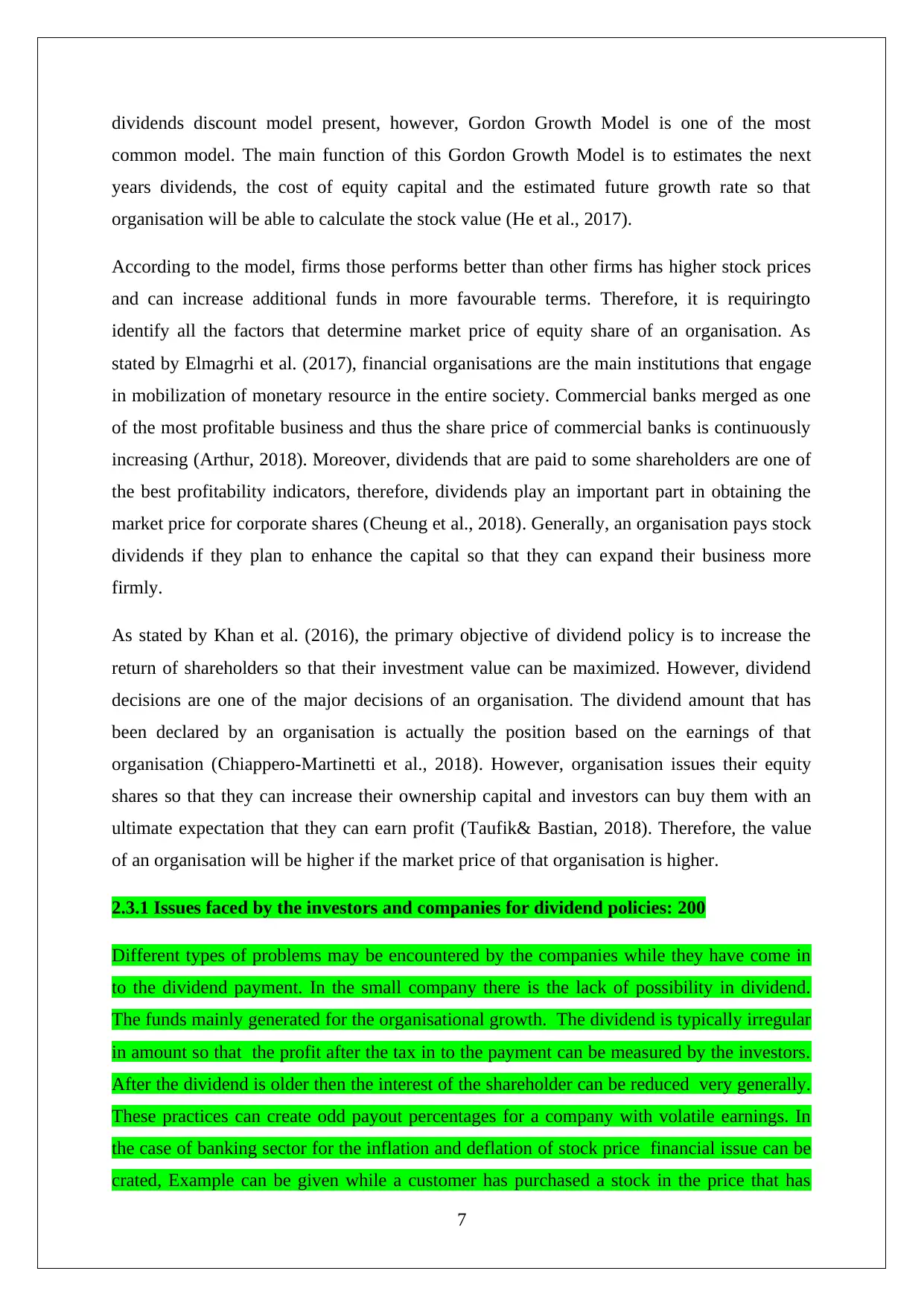
dividends discount model present, however, Gordon Growth Model is one of the most
common model. The main function of this Gordon Growth Model is to estimates the next
years dividends, the cost of equity capital and the estimated future growth rate so that
organisation will be able to calculate the stock value (He et al., 2017).
According to the model, firms those performs better than other firms has higher stock prices
and can increase additional funds in more favourable terms. Therefore, it is requiringto
identify all the factors that determine market price of equity share of an organisation. As
stated by Elmagrhi et al. (2017), financial organisations are the main institutions that engage
in mobilization of monetary resource in the entire society. Commercial banks merged as one
of the most profitable business and thus the share price of commercial banks is continuously
increasing (Arthur, 2018). Moreover, dividends that are paid to some shareholders are one of
the best profitability indicators, therefore, dividends play an important part in obtaining the
market price for corporate shares (Cheung et al., 2018). Generally, an organisation pays stock
dividends if they plan to enhance the capital so that they can expand their business more
firmly.
As stated by Khan et al. (2016), the primary objective of dividend policy is to increase the
return of shareholders so that their investment value can be maximized. However, dividend
decisions are one of the major decisions of an organisation. The dividend amount that has
been declared by an organisation is actually the position based on the earnings of that
organisation (Chiappero-Martinetti et al., 2018). However, organisation issues their equity
shares so that they can increase their ownership capital and investors can buy them with an
ultimate expectation that they can earn profit (Taufik& Bastian, 2018). Therefore, the value
of an organisation will be higher if the market price of that organisation is higher.
2.3.1 Issues faced by the investors and companies for dividend policies: 200
Different types of problems may be encountered by the companies while they have come in
to the dividend payment. In the small company there is the lack of possibility in dividend.
The funds mainly generated for the organisational growth. The dividend is typically irregular
in amount so that the profit after the tax in to the payment can be measured by the investors.
After the dividend is older then the interest of the shareholder can be reduced very generally.
These practices can create odd payout percentages for a company with volatile earnings. In
the case of banking sector for the inflation and deflation of stock price financial issue can be
crated, Example can be given while a customer has purchased a stock in the price that has
7
common model. The main function of this Gordon Growth Model is to estimates the next
years dividends, the cost of equity capital and the estimated future growth rate so that
organisation will be able to calculate the stock value (He et al., 2017).
According to the model, firms those performs better than other firms has higher stock prices
and can increase additional funds in more favourable terms. Therefore, it is requiringto
identify all the factors that determine market price of equity share of an organisation. As
stated by Elmagrhi et al. (2017), financial organisations are the main institutions that engage
in mobilization of monetary resource in the entire society. Commercial banks merged as one
of the most profitable business and thus the share price of commercial banks is continuously
increasing (Arthur, 2018). Moreover, dividends that are paid to some shareholders are one of
the best profitability indicators, therefore, dividends play an important part in obtaining the
market price for corporate shares (Cheung et al., 2018). Generally, an organisation pays stock
dividends if they plan to enhance the capital so that they can expand their business more
firmly.
As stated by Khan et al. (2016), the primary objective of dividend policy is to increase the
return of shareholders so that their investment value can be maximized. However, dividend
decisions are one of the major decisions of an organisation. The dividend amount that has
been declared by an organisation is actually the position based on the earnings of that
organisation (Chiappero-Martinetti et al., 2018). However, organisation issues their equity
shares so that they can increase their ownership capital and investors can buy them with an
ultimate expectation that they can earn profit (Taufik& Bastian, 2018). Therefore, the value
of an organisation will be higher if the market price of that organisation is higher.
2.3.1 Issues faced by the investors and companies for dividend policies: 200
Different types of problems may be encountered by the companies while they have come in
to the dividend payment. In the small company there is the lack of possibility in dividend.
The funds mainly generated for the organisational growth. The dividend is typically irregular
in amount so that the profit after the tax in to the payment can be measured by the investors.
After the dividend is older then the interest of the shareholder can be reduced very generally.
These practices can create odd payout percentages for a company with volatile earnings. In
the case of banking sector for the inflation and deflation of stock price financial issue can be
crated, Example can be given while a customer has purchased a stock in the price that has
7
Paraphrase This Document
Need a fresh take? Get an instant paraphrase of this document with our AI Paraphraser
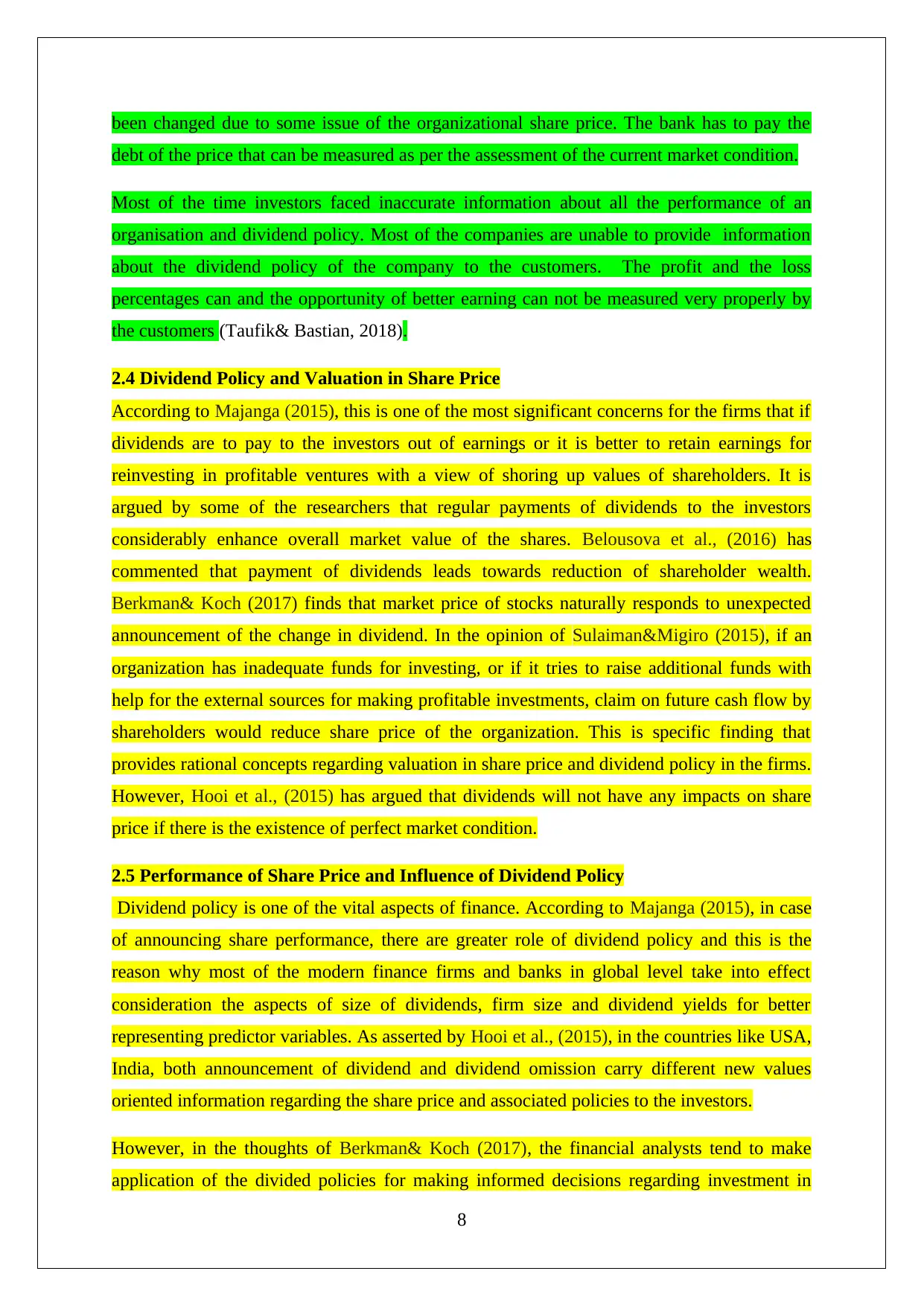
been changed due to some issue of the organizational share price. The bank has to pay the
debt of the price that can be measured as per the assessment of the current market condition.
Most of the time investors faced inaccurate information about all the performance of an
organisation and dividend policy. Most of the companies are unable to provide information
about the dividend policy of the company to the customers. The profit and the loss
percentages can and the opportunity of better earning can not be measured very properly by
the customers (Taufik& Bastian, 2018).
2.4 Dividend Policy and Valuation in Share Price
According to Majanga (2015), this is one of the most significant concerns for the firms that if
dividends are to pay to the investors out of earnings or it is better to retain earnings for
reinvesting in profitable ventures with a view of shoring up values of shareholders. It is
argued by some of the researchers that regular payments of dividends to the investors
considerably enhance overall market value of the shares. Belousova et al., (2016) has
commented that payment of dividends leads towards reduction of shareholder wealth.
Berkman& Koch (2017) finds that market price of stocks naturally responds to unexpected
announcement of the change in dividend. In the opinion of Sulaiman&Migiro (2015), if an
organization has inadequate funds for investing, or if it tries to raise additional funds with
help for the external sources for making profitable investments, claim on future cash flow by
shareholders would reduce share price of the organization. This is specific finding that
provides rational concepts regarding valuation in share price and dividend policy in the firms.
However, Hooi et al., (2015) has argued that dividends will not have any impacts on share
price if there is the existence of perfect market condition.
2.5 Performance of Share Price and Influence of Dividend Policy
Dividend policy is one of the vital aspects of finance. According to Majanga (2015), in case
of announcing share performance, there are greater role of dividend policy and this is the
reason why most of the modern finance firms and banks in global level take into effect
consideration the aspects of size of dividends, firm size and dividend yields for better
representing predictor variables. As asserted by Hooi et al., (2015), in the countries like USA,
India, both announcement of dividend and dividend omission carry different new values
oriented information regarding the share price and associated policies to the investors.
However, in the thoughts of Berkman& Koch (2017), the financial analysts tend to make
application of the divided policies for making informed decisions regarding investment in
8
debt of the price that can be measured as per the assessment of the current market condition.
Most of the time investors faced inaccurate information about all the performance of an
organisation and dividend policy. Most of the companies are unable to provide information
about the dividend policy of the company to the customers. The profit and the loss
percentages can and the opportunity of better earning can not be measured very properly by
the customers (Taufik& Bastian, 2018).
2.4 Dividend Policy and Valuation in Share Price
According to Majanga (2015), this is one of the most significant concerns for the firms that if
dividends are to pay to the investors out of earnings or it is better to retain earnings for
reinvesting in profitable ventures with a view of shoring up values of shareholders. It is
argued by some of the researchers that regular payments of dividends to the investors
considerably enhance overall market value of the shares. Belousova et al., (2016) has
commented that payment of dividends leads towards reduction of shareholder wealth.
Berkman& Koch (2017) finds that market price of stocks naturally responds to unexpected
announcement of the change in dividend. In the opinion of Sulaiman&Migiro (2015), if an
organization has inadequate funds for investing, or if it tries to raise additional funds with
help for the external sources for making profitable investments, claim on future cash flow by
shareholders would reduce share price of the organization. This is specific finding that
provides rational concepts regarding valuation in share price and dividend policy in the firms.
However, Hooi et al., (2015) has argued that dividends will not have any impacts on share
price if there is the existence of perfect market condition.
2.5 Performance of Share Price and Influence of Dividend Policy
Dividend policy is one of the vital aspects of finance. According to Majanga (2015), in case
of announcing share performance, there are greater role of dividend policy and this is the
reason why most of the modern finance firms and banks in global level take into effect
consideration the aspects of size of dividends, firm size and dividend yields for better
representing predictor variables. As asserted by Hooi et al., (2015), in the countries like USA,
India, both announcement of dividend and dividend omission carry different new values
oriented information regarding the share price and associated policies to the investors.
However, in the thoughts of Berkman& Koch (2017), the financial analysts tend to make
application of the divided policies for making informed decisions regarding investment in
8
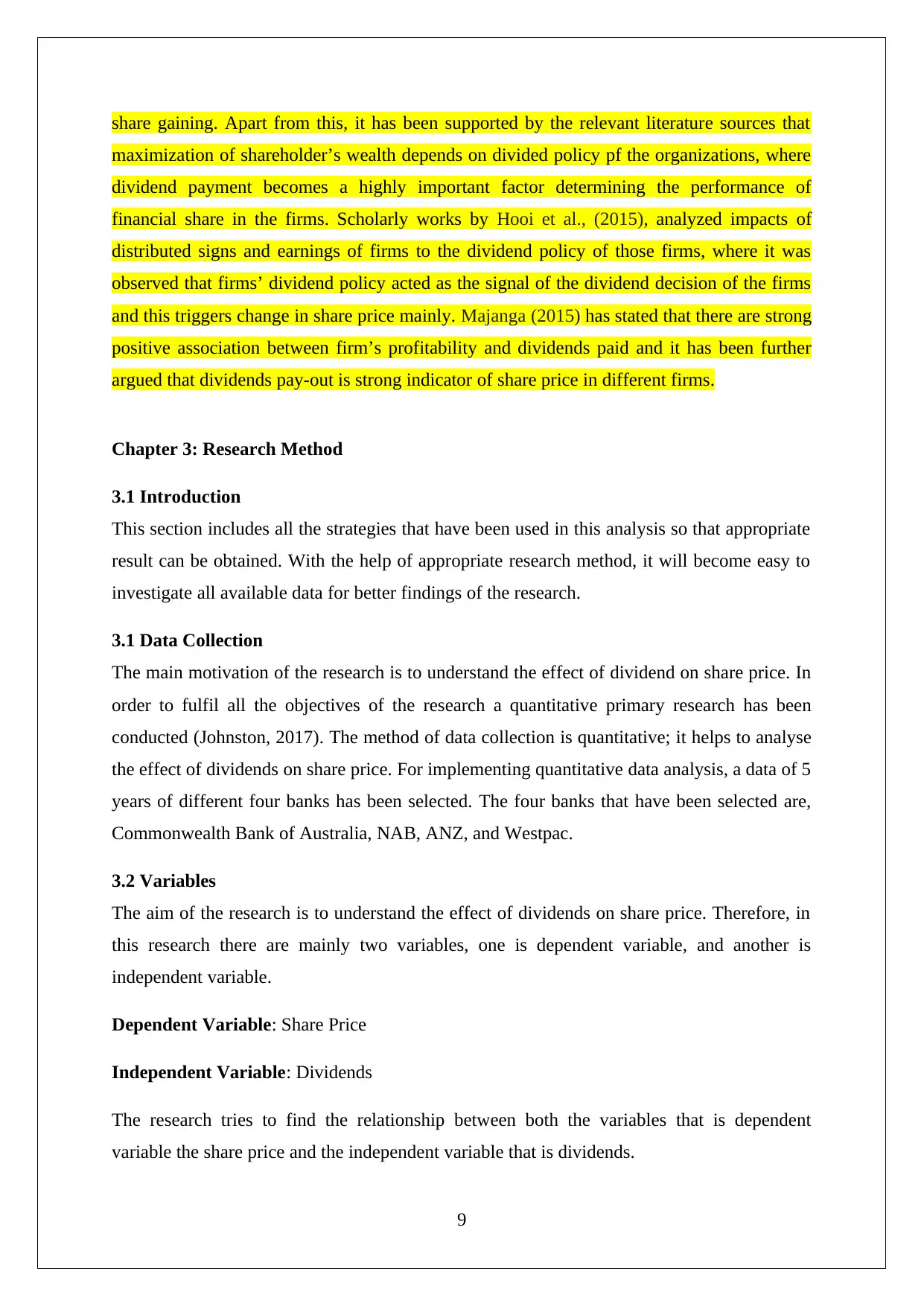
share gaining. Apart from this, it has been supported by the relevant literature sources that
maximization of shareholder’s wealth depends on divided policy pf the organizations, where
dividend payment becomes a highly important factor determining the performance of
financial share in the firms. Scholarly works by Hooi et al., (2015), analyzed impacts of
distributed signs and earnings of firms to the dividend policy of those firms, where it was
observed that firms’ dividend policy acted as the signal of the dividend decision of the firms
and this triggers change in share price mainly. Majanga (2015) has stated that there are strong
positive association between firm’s profitability and dividends paid and it has been further
argued that dividends pay-out is strong indicator of share price in different firms.
Chapter 3: Research Method
3.1 Introduction
This section includes all the strategies that have been used in this analysis so that appropriate
result can be obtained. With the help of appropriate research method, it will become easy to
investigate all available data for better findings of the research.
3.1 Data Collection
The main motivation of the research is to understand the effect of dividend on share price. In
order to fulfil all the objectives of the research a quantitative primary research has been
conducted (Johnston, 2017). The method of data collection is quantitative; it helps to analyse
the effect of dividends on share price. For implementing quantitative data analysis, a data of 5
years of different four banks has been selected. The four banks that have been selected are,
Commonwealth Bank of Australia, NAB, ANZ, and Westpac.
3.2 Variables
The aim of the research is to understand the effect of dividends on share price. Therefore, in
this research there are mainly two variables, one is dependent variable, and another is
independent variable.
Dependent Variable: Share Price
Independent Variable: Dividends
The research tries to find the relationship between both the variables that is dependent
variable the share price and the independent variable that is dividends.
9
maximization of shareholder’s wealth depends on divided policy pf the organizations, where
dividend payment becomes a highly important factor determining the performance of
financial share in the firms. Scholarly works by Hooi et al., (2015), analyzed impacts of
distributed signs and earnings of firms to the dividend policy of those firms, where it was
observed that firms’ dividend policy acted as the signal of the dividend decision of the firms
and this triggers change in share price mainly. Majanga (2015) has stated that there are strong
positive association between firm’s profitability and dividends paid and it has been further
argued that dividends pay-out is strong indicator of share price in different firms.
Chapter 3: Research Method
3.1 Introduction
This section includes all the strategies that have been used in this analysis so that appropriate
result can be obtained. With the help of appropriate research method, it will become easy to
investigate all available data for better findings of the research.
3.1 Data Collection
The main motivation of the research is to understand the effect of dividend on share price. In
order to fulfil all the objectives of the research a quantitative primary research has been
conducted (Johnston, 2017). The method of data collection is quantitative; it helps to analyse
the effect of dividends on share price. For implementing quantitative data analysis, a data of 5
years of different four banks has been selected. The four banks that have been selected are,
Commonwealth Bank of Australia, NAB, ANZ, and Westpac.
3.2 Variables
The aim of the research is to understand the effect of dividends on share price. Therefore, in
this research there are mainly two variables, one is dependent variable, and another is
independent variable.
Dependent Variable: Share Price
Independent Variable: Dividends
The research tries to find the relationship between both the variables that is dependent
variable the share price and the independent variable that is dividends.
9
⊘ This is a preview!⊘
Do you want full access?
Subscribe today to unlock all pages.

Trusted by 1+ million students worldwide
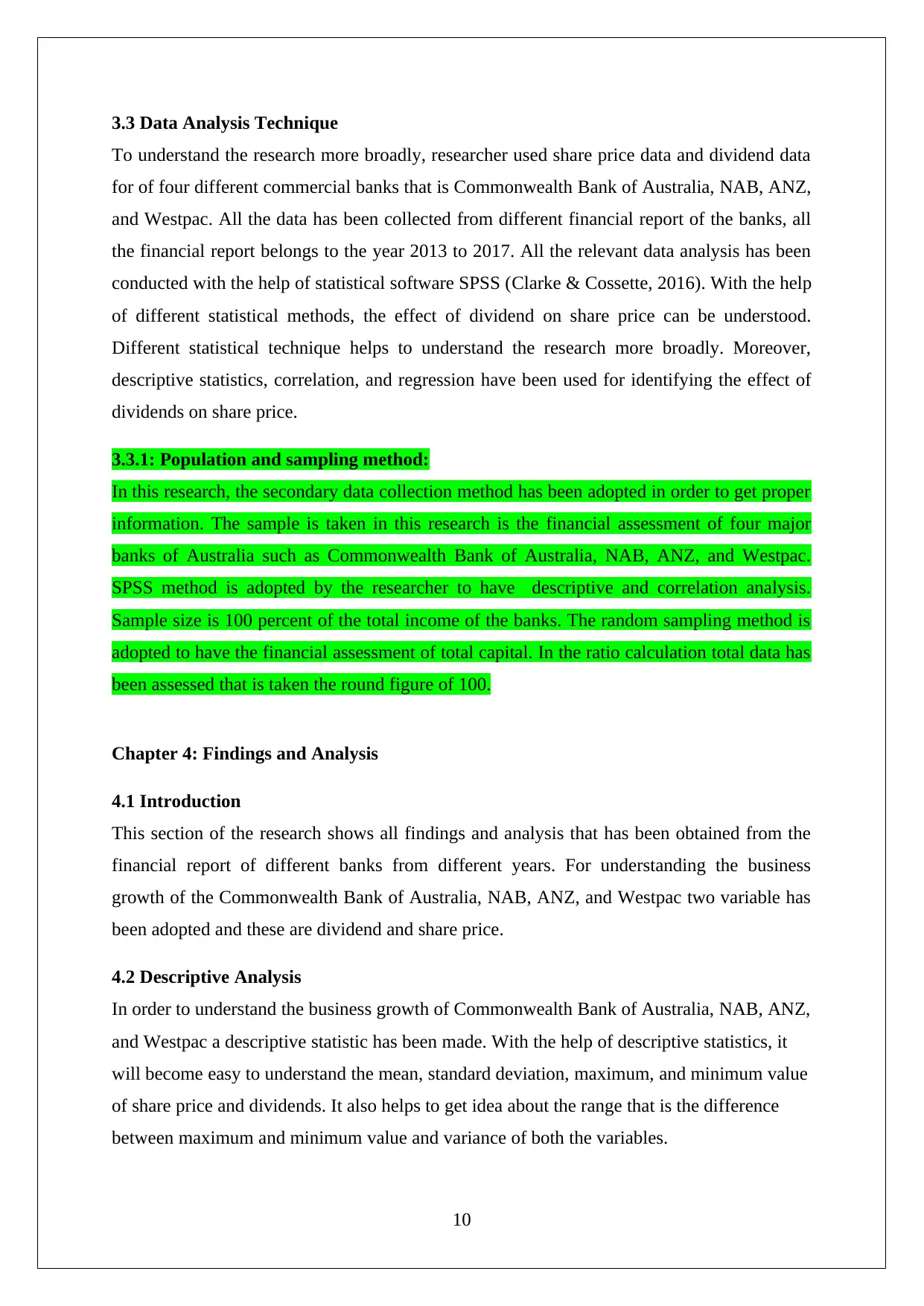
3.3 Data Analysis Technique
To understand the research more broadly, researcher used share price data and dividend data
for of four different commercial banks that is Commonwealth Bank of Australia, NAB, ANZ,
and Westpac. All the data has been collected from different financial report of the banks, all
the financial report belongs to the year 2013 to 2017. All the relevant data analysis has been
conducted with the help of statistical software SPSS (Clarke & Cossette, 2016). With the help
of different statistical methods, the effect of dividend on share price can be understood.
Different statistical technique helps to understand the research more broadly. Moreover,
descriptive statistics, correlation, and regression have been used for identifying the effect of
dividends on share price.
3.3.1: Population and sampling method:
In this research, the secondary data collection method has been adopted in order to get proper
information. The sample is taken in this research is the financial assessment of four major
banks of Australia such as Commonwealth Bank of Australia, NAB, ANZ, and Westpac.
SPSS method is adopted by the researcher to have descriptive and correlation analysis.
Sample size is 100 percent of the total income of the banks. The random sampling method is
adopted to have the financial assessment of total capital. In the ratio calculation total data has
been assessed that is taken the round figure of 100.
Chapter 4: Findings and Analysis
4.1 Introduction
This section of the research shows all findings and analysis that has been obtained from the
financial report of different banks from different years. For understanding the business
growth of the Commonwealth Bank of Australia, NAB, ANZ, and Westpac two variable has
been adopted and these are dividend and share price.
4.2 Descriptive Analysis
In order to understand the business growth of Commonwealth Bank of Australia, NAB, ANZ,
and Westpac a descriptive statistic has been made. With the help of descriptive statistics, it
will become easy to understand the mean, standard deviation, maximum, and minimum value
of share price and dividends. It also helps to get idea about the range that is the difference
between maximum and minimum value and variance of both the variables.
10
To understand the research more broadly, researcher used share price data and dividend data
for of four different commercial banks that is Commonwealth Bank of Australia, NAB, ANZ,
and Westpac. All the data has been collected from different financial report of the banks, all
the financial report belongs to the year 2013 to 2017. All the relevant data analysis has been
conducted with the help of statistical software SPSS (Clarke & Cossette, 2016). With the help
of different statistical methods, the effect of dividend on share price can be understood.
Different statistical technique helps to understand the research more broadly. Moreover,
descriptive statistics, correlation, and regression have been used for identifying the effect of
dividends on share price.
3.3.1: Population and sampling method:
In this research, the secondary data collection method has been adopted in order to get proper
information. The sample is taken in this research is the financial assessment of four major
banks of Australia such as Commonwealth Bank of Australia, NAB, ANZ, and Westpac.
SPSS method is adopted by the researcher to have descriptive and correlation analysis.
Sample size is 100 percent of the total income of the banks. The random sampling method is
adopted to have the financial assessment of total capital. In the ratio calculation total data has
been assessed that is taken the round figure of 100.
Chapter 4: Findings and Analysis
4.1 Introduction
This section of the research shows all findings and analysis that has been obtained from the
financial report of different banks from different years. For understanding the business
growth of the Commonwealth Bank of Australia, NAB, ANZ, and Westpac two variable has
been adopted and these are dividend and share price.
4.2 Descriptive Analysis
In order to understand the business growth of Commonwealth Bank of Australia, NAB, ANZ,
and Westpac a descriptive statistic has been made. With the help of descriptive statistics, it
will become easy to understand the mean, standard deviation, maximum, and minimum value
of share price and dividends. It also helps to get idea about the range that is the difference
between maximum and minimum value and variance of both the variables.
10
Paraphrase This Document
Need a fresh take? Get an instant paraphrase of this document with our AI Paraphraser
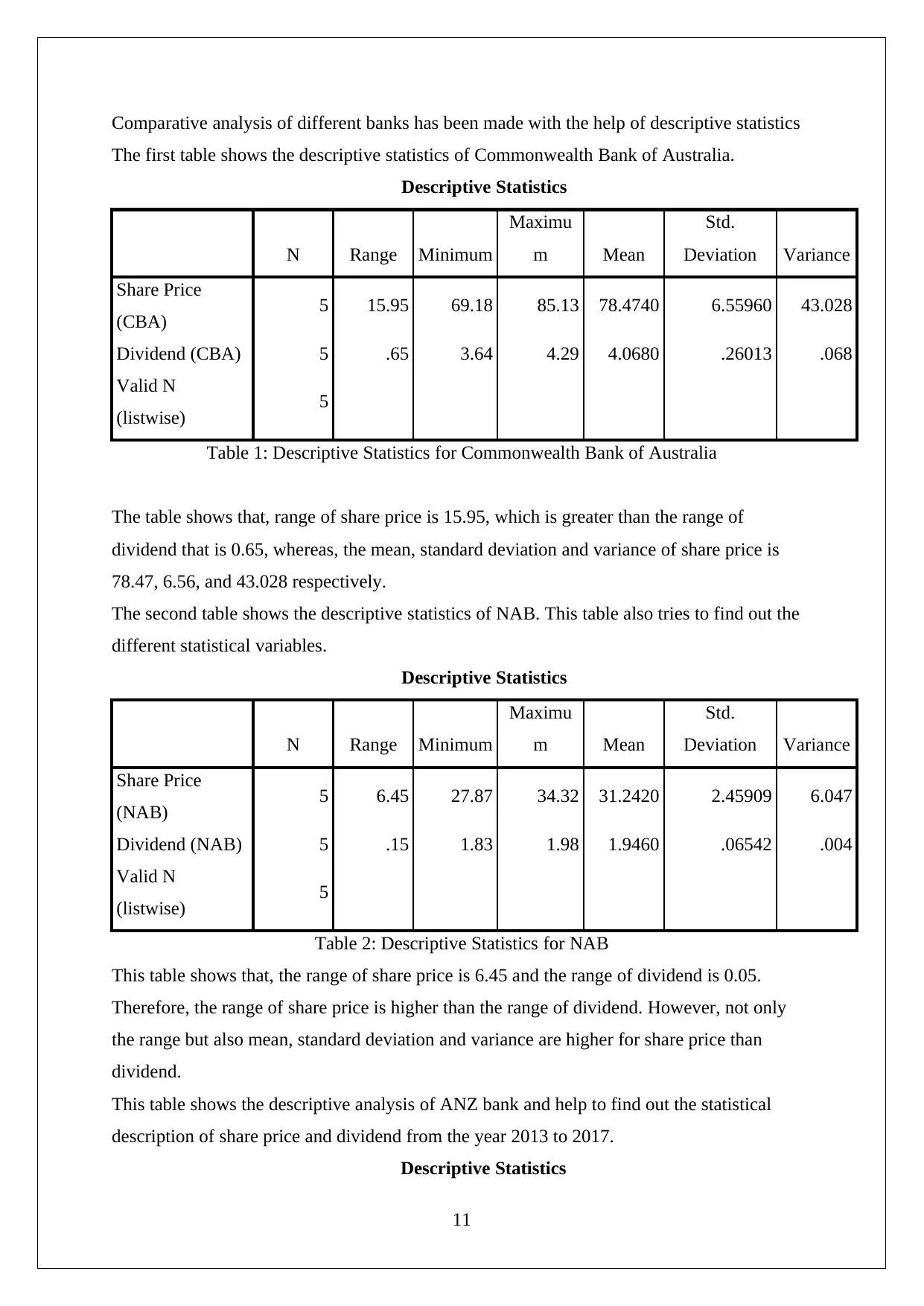
Comparative analysis of different banks has been made with the help of descriptive statistics
The first table shows the descriptive statistics of Commonwealth Bank of Australia.
Descriptive Statistics
N Range Minimum
Maximu
m Mean
Std.
Deviation Variance
Share Price
(CBA) 5 15.95 69.18 85.13 78.4740 6.55960 43.028
Dividend (CBA) 5 .65 3.64 4.29 4.0680 .26013 .068
Valid N
(listwise) 5
Table 1: Descriptive Statistics for Commonwealth Bank of Australia
The table shows that, range of share price is 15.95, which is greater than the range of
dividend that is 0.65, whereas, the mean, standard deviation and variance of share price is
78.47, 6.56, and 43.028 respectively.
The second table shows the descriptive statistics of NAB. This table also tries to find out the
different statistical variables.
Descriptive Statistics
N Range Minimum
Maximu
m Mean
Std.
Deviation Variance
Share Price
(NAB) 5 6.45 27.87 34.32 31.2420 2.45909 6.047
Dividend (NAB) 5 .15 1.83 1.98 1.9460 .06542 .004
Valid N
(listwise) 5
Table 2: Descriptive Statistics for NAB
This table shows that, the range of share price is 6.45 and the range of dividend is 0.05.
Therefore, the range of share price is higher than the range of dividend. However, not only
the range but also mean, standard deviation and variance are higher for share price than
dividend.
This table shows the descriptive analysis of ANZ bank and help to find out the statistical
description of share price and dividend from the year 2013 to 2017.
Descriptive Statistics
11
The first table shows the descriptive statistics of Commonwealth Bank of Australia.
Descriptive Statistics
N Range Minimum
Maximu
m Mean
Std.
Deviation Variance
Share Price
(CBA) 5 15.95 69.18 85.13 78.4740 6.55960 43.028
Dividend (CBA) 5 .65 3.64 4.29 4.0680 .26013 .068
Valid N
(listwise) 5
Table 1: Descriptive Statistics for Commonwealth Bank of Australia
The table shows that, range of share price is 15.95, which is greater than the range of
dividend that is 0.65, whereas, the mean, standard deviation and variance of share price is
78.47, 6.56, and 43.028 respectively.
The second table shows the descriptive statistics of NAB. This table also tries to find out the
different statistical variables.
Descriptive Statistics
N Range Minimum
Maximu
m Mean
Std.
Deviation Variance
Share Price
(NAB) 5 6.45 27.87 34.32 31.2420 2.45909 6.047
Dividend (NAB) 5 .15 1.83 1.98 1.9460 .06542 .004
Valid N
(listwise) 5
Table 2: Descriptive Statistics for NAB
This table shows that, the range of share price is 6.45 and the range of dividend is 0.05.
Therefore, the range of share price is higher than the range of dividend. However, not only
the range but also mean, standard deviation and variance are higher for share price than
dividend.
This table shows the descriptive analysis of ANZ bank and help to find out the statistical
description of share price and dividend from the year 2013 to 2017.
Descriptive Statistics
11
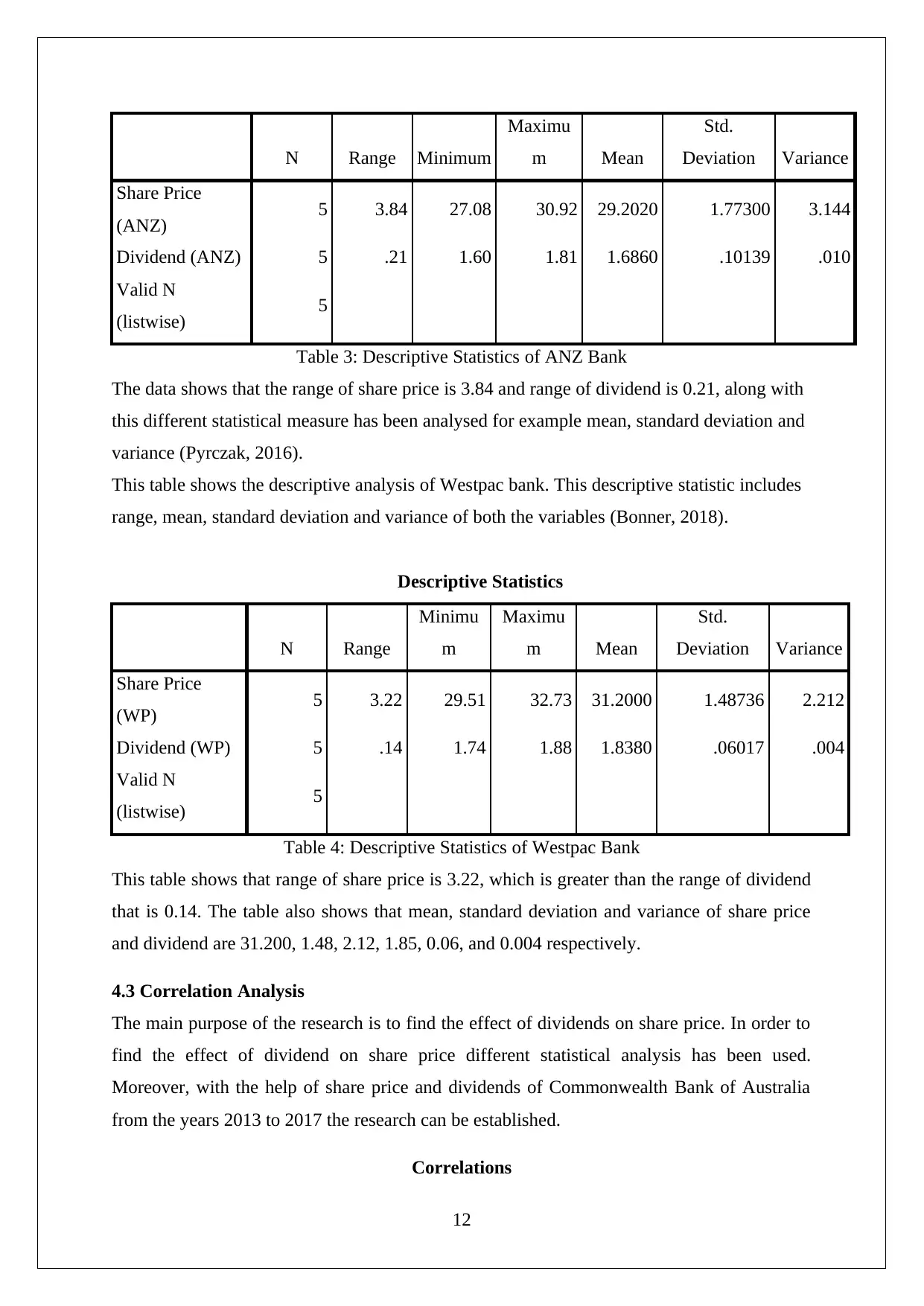
N Range Minimum
Maximu
m Mean
Std.
Deviation Variance
Share Price
(ANZ) 5 3.84 27.08 30.92 29.2020 1.77300 3.144
Dividend (ANZ) 5 .21 1.60 1.81 1.6860 .10139 .010
Valid N
(listwise) 5
Table 3: Descriptive Statistics of ANZ Bank
The data shows that the range of share price is 3.84 and range of dividend is 0.21, along with
this different statistical measure has been analysed for example mean, standard deviation and
variance (Pyrczak, 2016).
This table shows the descriptive analysis of Westpac bank. This descriptive statistic includes
range, mean, standard deviation and variance of both the variables (Bonner, 2018).
Descriptive Statistics
N Range
Minimu
m
Maximu
m Mean
Std.
Deviation Variance
Share Price
(WP) 5 3.22 29.51 32.73 31.2000 1.48736 2.212
Dividend (WP) 5 .14 1.74 1.88 1.8380 .06017 .004
Valid N
(listwise) 5
Table 4: Descriptive Statistics of Westpac Bank
This table shows that range of share price is 3.22, which is greater than the range of dividend
that is 0.14. The table also shows that mean, standard deviation and variance of share price
and dividend are 31.200, 1.48, 2.12, 1.85, 0.06, and 0.004 respectively.
4.3 Correlation Analysis
The main purpose of the research is to find the effect of dividends on share price. In order to
find the effect of dividend on share price different statistical analysis has been used.
Moreover, with the help of share price and dividends of Commonwealth Bank of Australia
from the years 2013 to 2017 the research can be established.
Correlations
12
Maximu
m Mean
Std.
Deviation Variance
Share Price
(ANZ) 5 3.84 27.08 30.92 29.2020 1.77300 3.144
Dividend (ANZ) 5 .21 1.60 1.81 1.6860 .10139 .010
Valid N
(listwise) 5
Table 3: Descriptive Statistics of ANZ Bank
The data shows that the range of share price is 3.84 and range of dividend is 0.21, along with
this different statistical measure has been analysed for example mean, standard deviation and
variance (Pyrczak, 2016).
This table shows the descriptive analysis of Westpac bank. This descriptive statistic includes
range, mean, standard deviation and variance of both the variables (Bonner, 2018).
Descriptive Statistics
N Range
Minimu
m
Maximu
m Mean
Std.
Deviation Variance
Share Price
(WP) 5 3.22 29.51 32.73 31.2000 1.48736 2.212
Dividend (WP) 5 .14 1.74 1.88 1.8380 .06017 .004
Valid N
(listwise) 5
Table 4: Descriptive Statistics of Westpac Bank
This table shows that range of share price is 3.22, which is greater than the range of dividend
that is 0.14. The table also shows that mean, standard deviation and variance of share price
and dividend are 31.200, 1.48, 2.12, 1.85, 0.06, and 0.004 respectively.
4.3 Correlation Analysis
The main purpose of the research is to find the effect of dividends on share price. In order to
find the effect of dividend on share price different statistical analysis has been used.
Moreover, with the help of share price and dividends of Commonwealth Bank of Australia
from the years 2013 to 2017 the research can be established.
Correlations
12
⊘ This is a preview!⊘
Do you want full access?
Subscribe today to unlock all pages.

Trusted by 1+ million students worldwide
1 out of 21
Related Documents
Your All-in-One AI-Powered Toolkit for Academic Success.
+13062052269
info@desklib.com
Available 24*7 on WhatsApp / Email
![[object Object]](/_next/static/media/star-bottom.7253800d.svg)
Unlock your academic potential
Copyright © 2020–2025 A2Z Services. All Rights Reserved. Developed and managed by ZUCOL.





